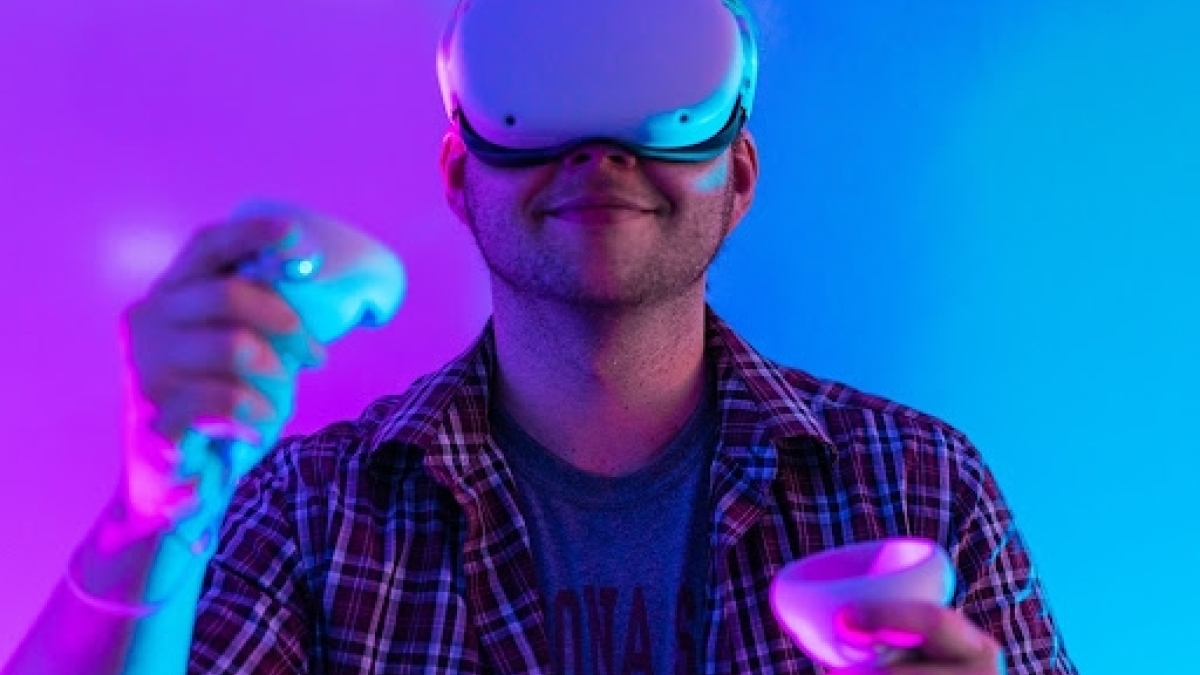The campus of the future is here.
Students at Learning Futures are building a virtual replica — also known as a digital twin — of Arizona State University’s Tempe campus, with plans to expand in the near future. They’re calling it the ASUniverse, and designing it to connect fellow students in the metaverse.
Teams at Learning Futures, which is part of ASU Enterprise Technology, focus on exploring and designing immersive learning experiences three to five years into the future.
The student-led collaborative effort aims to blur the lines between the physical and digital environment by allowing students to participate in campus tours, events and classes in an immersive experience from anywhere with access to the internet.
“It's part of this human evolution that's going on where we're becoming integrated with our technology,” said Jesse Murdock, a graduate student studying architecture and a digital twin specialist at Learning Futures. “Our technology is just an extension of ourselves that allows us to connect at a level that brings the world closer.”
The ASUniverse is a digital twin — an evolving, virtual representation of the physical environment influenced by data collected on campus. Soon, Sun Devils will be able to explore the breathtaking architecture, the cutting-edge classrooms and even the Southwest landscape from anywhere in a real-time, 3D experience.
“Digital twins and online worlds like Roblox, Minecraft and Meta Horizons are changing how we live, work and play online,” said Dan Munnerley, executive director of Learning Futures. “This paradigm shift towards real-time 3D holds a great opportunity for education. Our students already inhabit these worlds, so who better to design the online campus of the future than our learners?”
Video by Alisha Mendez
“This digital space will allow you to do and see all the things in the physical world — plus more,” said Toby Kidd, director of studios at Learning Futures. “Like the ability to travel to locations where you normally wouldn’t be able to go, whether it is because of limited access or limited funding.”
One recent development project focused on bringing Zoom into the ASUniverse. This was inspired by the launch of the Zoom Innovation Lab at ASU in October.
Using avatars, virtual guests will be able to navigate throughout the ASUniverse and, at designated virtual Zoom kiosks, connect via live Zoom meetings with real people such as professors, TAs and other student services personnel. The Zoom room acts as a window to the physical world for those in the ASUniverse, allowing students to connect their avatars with real people in the metaverse.
This project is an innovative example of bridging the physical and virtual worlds.
“There's a really strong sense of community here on campus,” said Kidd. “And if you are a remote student, the ability for you to connect on campus through a virtual experience is a really awesome opportunity.”
What’s more, the ASUniverse can adapt and change in real time — from the clouds in the sky, to the time of day and even the number of people in the area — all with the click of a mouse. Development tools like Unreal and Unity are being used to make this possible.
“We can use a digital twin to do shadow studies and decide where we should put our solar panels for new buildings, for example,” said Murdock. “We can start to answer how we can create more sustainable systems based on what is already here.”
While the ASUniverse is not yet open, this is only the beginning. In the meantime, ASU students will continue to gather data and take broad steps toward creating a digital future that blends the physical and virtual worlds to create greater access to learning from around the globe.
“We don't know what the world is going to look like in three to five years, but you put out a target and you work toward that,” Kidd said. “The potential for virtual spaces is limitless.”
Written by Kevin Pirehpour
Top photo: Teams at Learning Futures, which is part of ASU Enterprise Technology, focus on exploring and designing immersive learning experiences, which aim to blur the lines between the physical and digital environment by allowing remote students to participate in campus tours, events and classes. Photo by Kevin Pirehpour
More Science and technology

ASU and Deca Technologies selected to lead $100M SHIELD USA project to strengthen U.S. semiconductor packaging capabilities
The National Institute of Standards and Technology — part of the U.S. Department of Commerce — announced today that it plans to award as much as $100 million to Arizona State University and Deca…

From food crops to cancer clinics: Lessons in extermination resistance
Just as crop-devouring insects evolve to resist pesticides, cancer cells can increase their lethality by developing resistance to treatment. In fact, most deaths from cancer are caused by the…

ASU professor wins NIH Director’s New Innovator Award for research linking gene function to brain structure
Life experiences alter us in many ways, including how we act and our mental and physical health. What we go through can even change how our genes work, how the instructions coded into our DNA are…
